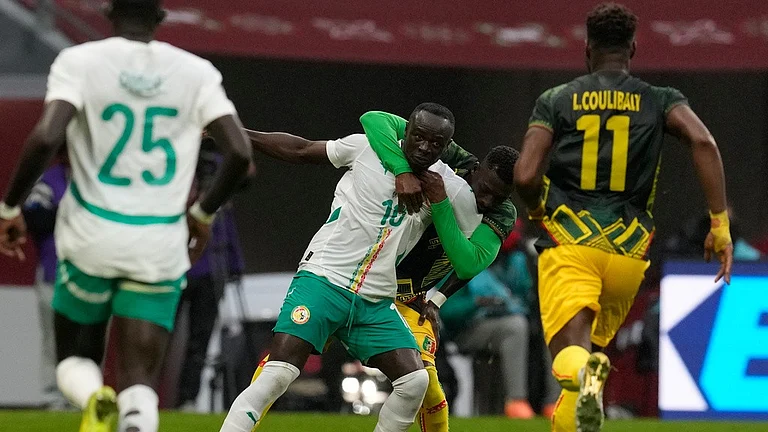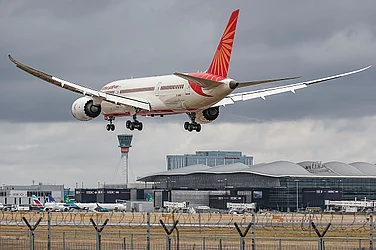“Once, we collected excess food from a wedding in Surat that ended up feeding 10K people! It is ridiculous how much food gets wasted in India during weddings. In fact, whenever a ‘robin’ gets married, their wedding card mentions that all surplus food will be given to us,” says Neel Ghose, who heads Robin Hood Army (RHA), run by 200,000 ‘robins’ across 279 Indian cities and 13 countries, and has 8-10K new robins signing up per month. Co-founded by Aarushi Batra and Sanchit Jain, the ‘volunteer-based zero-fund’ organisation’ serves 1.5-2M meals per month and has hit 90M (and counting) meals. RHA recently launched in Bangladesh, Zambia, and also has a Karachi chapter that has served 11M in last seven years, 10M in the last two years alone.
"In Karachi, it is more powerful. If a customer sees a RHA sticker in a restaurant, they are more likely to eat there. It’s become almost business sense to give food to us,” informs Ghose. Two years ago, RHA became a case study in Harvard’s full-time MBA programme for its scale and no-cost policy. “We share lot of our journey and the act of giving on social media to our half a million followers. Essentially, we are quite decentralised, and let the local team decide on the type of food or rations they are comfortable with or have access to distribute, because sitting in Gurugram, we cannot tell what are the best food items to distribute in Junagarh or Patna,” informs Neel, employed with GooglePay. All the robins have full-time jobs and undertake RHA activities in their free time.
The fictional Robin Hood from English folkfore was an ace swordsmen and archer dressed Lincoln green, who with an all-men band stopped horse carriages cutting through dense forests, usually carrying royalty, abbots or wealthy mercenary, and looted them, only to distribute the exploits among the poor. While RHA borrows the green hue and archer stance for their t-shirts and the ideology of taking from the wealthy to combat escalating hunger crisis in India. RHA has forged consistent partnerships with The Lalit, Godrej, Hindustan Lever, KFC, McDonalds. After from the usual work in respective clusters (adopted areas), when one part of the country is affected, RHA mobilises interstate collection and distribution of resources. During the 2015 drought in Latur, Maharashtra, robins across Pune and Mumbai, collaborated with the railways to transport water every Monday, Wednesday and Friday organised water. For the recurring floods in Kerala and Assam in the last two years, the robins across India managed to transport food, medicines, and clothing items.
Due to the confidence from having orchestrated such interstate drives, the RHA could handle an unprecedented event like the COVID-19 pandemic. “People didn’t have rations, food, resources and were falling sick. The problem was hunger, and how to satiate it. Our audience completely changed and had extended to handcart and rickshaw pullers, sabzi wallahs, auto drivers, and the migrants, because all of them were out of jobs,” recalls Shreya Nigam, a 22-year-old the full-time software developer and RHA Gurugram chapter head of 17 clusters.
RHA plans a unique food initiative around every Independence Day, and from July 1-August 15, 2020, the organisation launched an aggressive campaign called Mission30M with the aim to feed 30M people across India, and managed to serve 23.2M. “We pivoted our entire plan on dry rations by corporate donors and industrialists. Our robins travelled close to 30 km to deliver these rations. We even reached Sundarbans that had many migrants return. Our robins took ferries or small boats from Calcutta to consistently run food campaigns and completely adopted these communities. As the restaurants was severely impacted, we adapted a community-based model in places like Hyderabad, where every household in certain housing societies cooked one extra meal as surplus for RHA to serve.” With schools shut, the Akshaya Patra Foundation donated the dry rations otherwise used in their mid-day meals for students to RHA clusters. In Gurugram alone, RHA distributed 1,400 kits of ration, each kit of 13kg having dal rice, vegetable oil, and flour. Armed with an FSSAI partnership, RHA received prompt clearances for interstate transport of rations, VAT exemptions/reductions, etc. Moreover, their 2021 I-Day campaign, called #Mission28States, managed to get close to 0.1M people vaccinated, and overall 0.2M.
While RHA has accessed almost every avenue for possible for food redistribution, funeral food remains largely untouched. Nigam remembers there was just one case in the pandemic, but even that proved unsuccessful. “The deceased member's family had approached us, but later didn’t take our calls, maybe because of the ongoing rituals or they were not the right frame of mind. And you can’t keep calling a grieving person to coordinate for pickup and distribution,” says Nigam. Other hiccups involve dealing with corporate messes that have too many norms and rules concerning leftovers, says Nigam. “We used to collect surplus food from a Japanese automaker that has the biggest mess in Delhi-NCR, but discontinued because logistically it was not viable for us to travel and at times the food went bad.” Even time is a factor, and both the giver and redistributor need to put in effort.
“One has to wait with the leftovers till we reach them and even then, they cannot just dump it on us but wait till we test the food, pack it and leave.” Overall, the do-gooders outnumber the doubters. “People have come forward to sponsor freshly cooked food. A few cafes and pubs in Gurugram like The Big Tree Café and Ibis hotels specially cook khichdi or dal rice for us. Nandos has given us chicken and rice box meals. Every weekend, we get calls to pick up food from at least 6-7 locations. Most of the people giving us freshly cooked food do it with so much love that these meals are generally of the best quality.” Ghose adds, “In the pandemic, people got a closer look at those who can’t afford two square meals a day, and relaxed their reservations on realising they have the resources to save lives.”
The attitude of a big, fat Indian wedding, however, still persists, despite people still reeling from pandemic losses in their business, says Pranav Khanna, an operations manager at Food Aar8 Services, and associated with RHA for two years. “Covid has not changed anything. Most of my clients constitute HNIs (High Networking Individuals), and are aware of India’s burgeoning food crisis Yet they insist, khana kam nahi padana chahiye, waste hoga chalega (the food must not fall short, it is okay if the food gets wasted). At times, clients tell us to expect 20-30 more guests, and so for a 500-odd gathering, we cook for 550-570 people. If those guests don’t turn up, that food gets wasted. There is always surplus leftover after a huge gathering.”
If it’s a friend’s gathering or the client is approachable, Khanna prepares more than the quantity ordered as surplus food for the RHA drives. “I inform the clients that we will exclude them from these additional costs. It’s just one good deed we are trying to do. Usually clients are not concerned with the leftovers once every guest is served.” But at times, if the client is not happy with the service, either because a dish was bad or so good that it got over but the guests want more, or some other flaw in the catering service, “then I don’t tell them about RHA. A few clients, out of their own personal biases, preferred the surplus is discarded in the dustbin instead of giving it to RHA. But others are receptive to the idea that even though they have paid for the surplus food, it is being donated on their behalf.” Even most caterers, he says, prefer to discard surplus meals as in the past Delhi has witnessed incidents of people dying from food poisoning after consuming leftovers donated by caterers. “It becomes impossible to detect whether the person died from a pre-existing condition that got aggravated by an ingredient in the leftovers or the food itself was contaminated. Caterers don’t want the authorities coming after them.”
RHA has a few strict rules to ensure food safety. Given their no-fund policy leaves no room for storage devices, the food must be redistributed within three hours of collecting it from the food giver. The volunteers test the food for taste, quality and hygiene before redistribution. Depending on climate/area, they don’t accept highly perishable foods. Given the strict three-hour rule, Khanna rings up RHA the moment an event has concluded, which could even mean 2:30am. “But the robins have even reached at 4am to collect the food! Over the call, they ask what dishes will be handed out and accordingly bring along the suitable containers.”
For steaming curries and dal, the robins get casseroles or insulated containers, and for rotis, its foil wrap. Pranav prefers giving out rice, curry, roti and sabzi leftovers. “Unlike the Indian cuisine where tawa and gravy items can be reheated and eaten, in continental cuisine the vegetables are not fried and have higher chances of becoming stale, and cannot ask RHA to mix the vegetables with another dish.” During the 6-7 months wedding season, he ends up calling RHA about 5-6 times per month, and 1-2 times for rest of the year. “The best part is they have always sent me pictures of where and to whom the food was redistributed to within an hour of pickup.”
In their attempts to combat hunger, RHA has also found solutions for other problems that their clusters are facing apart from hunger. Like the Robin Hood Academy units functional in 150 Indian cities that teach around 8K children and got 2.5K enrolled in schools. Plus the child and their families are fed daily. “In Pune, we realised people were losing eyesight, and so one robin, a doctor, organised free cataract surgeries from his hospital. The vision of 48 people improved and two even got their eyesight back,” Ghose recalls. However, any initiative that requires capital investment and recurring maintenance, like the community fridge model, is not workable as it does not comply with the RHA zero-fund policy. Apart from aiming to feed a target of 10M by the 75th I-Day this year, the organisation also has partnered with FOSS United, is building a web app for our volunteers. “So many people are unaware that 200M in India don’t get two square meals a day. It’s unfair to expect the government to take care of it when as citizens we have certain resources that can make a difference. Everyone must take ownership in the fight against hunger,” concludes Ghose.


























